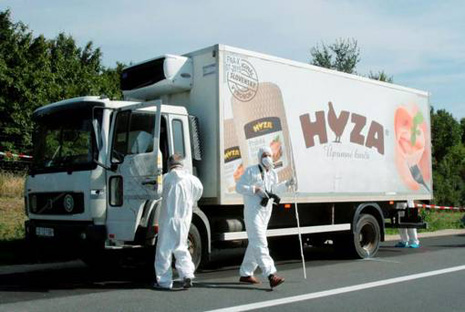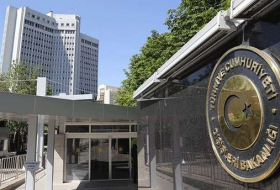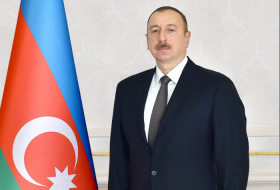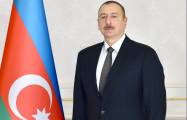Discovery of more than 70 bodies in truck highlights European migrant crisis - VIDEO

The incident came as top European officials were huddling in the Austrian capital, partly to discuss the biggest wave of refugees pouring into Europe since World War II, with most of them coming from war-torn countries in the Middle East, Africa and Asia.
The record surge so far this year has brought almost 300,000 desperate migrants into Europe by sea, surpassing the 217,000 who arrived during the whole of 2014. Many are asylum-seekers traveling from southern entry points such as Greece toward promised lands such as Germany, Austria and Sweden, where successful applicants can win generous benefits. But European nations remain divided over how much responsibility to take for their safe passage, as well as which nations should take them.
Deaths of migrants at sea and, to a lesser degree, on land are rising. Late Thursday, the Reuters news agency quoted an unidentified Libyan official as saying that a boat full of migrants heading for Italy had sunk off the Libyan coast, leaving as many as 200 dead. About 4,400 migrants were picked up in the Channel of Sicily on Saturday and Sunday in what the International Organization for Migration called one of the busiest weekends for search-and-rescue operations in the Mediterranean since the start of the year.
A booming smuggling industry has arisen both on land and sea, and authorities suspect the bodies found in the truck on Thursday were the result of a trafficking operation gone terribly wrong.
Austria reacted to the tragedy by announcing plans geared more toward blocking than aiding asylum-seekers, vowing to increase border controls and impose stiffer penalties on smugglers.
Speaking in Vienna, German Chancellor Angela Merkel said she was “shaken by the terrible news that up to 50 people have lost their lives because they ended up in a situation where traffickers did not care about this life.”
“This reminds us that we must tackle the issue of immigration quickly and in a European spirit,” she said. “That means in a spirit of solidarity — to find solutions.”
Austrian officials were searching for the truck driver and any witnesses, as well as conducting an international probe. The truck discovered Thursday had a temporary Hungarian license plate. The side of the 7.5-ton vehicle was emblazoned with the logo of a Slovakian chicken processing company, Hyza, whose parent company, Agrofert Holding, said the truck had been sold in 2014, according to the Associated Press.
Hans-Peter Doskozil, chief of police for the eastern Austrian state of Burgenland, said the bodies were being kept on the truck, which was brought to a climate-controlled inspection facility in the city of Nickelsdorf that was slated to become a refugee center. Doskozil said the suspected migrants appeared to have been dead at least 36 hours. Showing effects of the recent summer heat, the bodies were so decomposed that officials could not immediately determine whether there were women and children among the fatalities.
Dorottya Kelemen, a journalist with the Austrian public broadcaster ORF who was at the scene, reported that the side of the truck had been dented. To her, it looked as if the victims had tried to force their way out.
Highway tollbooth cameras registered the truck on the Hungarian side of the border at 9 p.m. Wednesday and again at 5 a.m. Thursday, suggesting, Doskozil said, that the truck had crossed into Austria during the night.
Police were trying to determine the cause of death; Wolfgang Bachkönig, Burgenland police spokesman, said they suspect suffocation. The bodies were to be handed over to forensic investigators Friday morning.
Although the identity of the victims remained unknown, the nature of the discovery suggested to authorities that they were migrants, record numbers of whom are traveling the same corridor — often with smugglers — every day. Despite the tragedy, Doskozil said he did not expect a reduction in the number of refugees attempting to cross the Austrian border, which is now topping 300 a day.
“Despite the tragic situation, we are confronted with the fact that we are expecting a massive increase” in crossings, he said.
A shift in the dangerous trail
Europe has few tools at its disposal to mitigate the migrant surge, and efforts to broaden the region’s arsenal have been marked by dissension and delays.
In May, European leaders agreed to launch a military operation to intercept and destroy smugglers’ ships in the Mediterranean. But the effort has bogged down in negotiations at the United Nations, where Russia has been reluctant to approve a proposed Security Council resolution authorizing the venture.
Even if it advances, a sea-based military operation would be of little use to address the surging numbers along Europe’s eastern flank, where migrants travel in flimsy rubber dinghies across narrow straits in order to reach Greece and then head northward through the Balkans over land.
Should the victims be conclusively declared migrants, the tragedy would indeed highlight the shifting geography of Europe’s refugee crisis as well as its mounting death toll.
Last year, the majority of migrants crossing into Europe did so via Libya, risking a dangerous passage across the central Mediterranean to land in Italy, where they then encountered relatively safe and open borders to the rest of the European Union.
This year, the epicenter of the crisis has shifted. More migrants — mostly Syrians and Iraqis — are traveling from Turkey into financially crippled Greece, which is offering little or no aid and is separated from the rest of the European Union by the Balkans. So migrants are making another journey over land, risking criminal gangs and dangerous passages to make it to nations further northwest that are offering generous benefits for those refugees found to be genuine asylum-
seekers.
Most migrant deaths continue to happen at sea — at least 2,440 so far this year. But more than a dozen migrants have died on land journeys this year, according to Doctors Without Borders.
In recent days, the situation has grown more dire as a throng of refugees attempts to rush through Hungary, which is building a 108-mile razor-wire fence on its border with Serbia to keep them out. Frantic scenes have occurred as migrants search for ways through the razor wire. Many migrants are turning to smugglers to get them through.
“The desperation to get across Hungary is growing,” said Stephane Moissaing, Serbian coordinator for Doctors Without Borders.
Responding to Thursday’s tragedy, Austrian Chancellor Werner Faymann appeared to chide Hungary for building “a wall.”
“When it comes to this issue, there is no looking away,” he told the German news broadcaster N24. “Not everyone is building a wall with a watchtower because he has lost trust that Europe can cope with this in a united way.”
In addition to announcing new measures to control its own borders, Austria on Thursday also floated a broader five-point plan to tackle the roots of the refugee crisis, including the creation of reception centers in Africa and the Middle East where European nations could assess asylum requests.
Yet just as with the new fence in Hungary, few experts believe such centers would deter refugees from making risky trips. In the meantime, European officials are attempting to reach a consensus over a plan to create a quota system in which refugees would be safely taken from entry points such as Greece to other nations in the European Union. Thus far, the plan has been thwarted by several nations, including Britain.
“It doesn’t matter if we have 50 more people dead, there is still opposition; the turning point is still not there,” said Katerina Kratzmann, head of the International Organization for Migration’s Austrian Office.














































